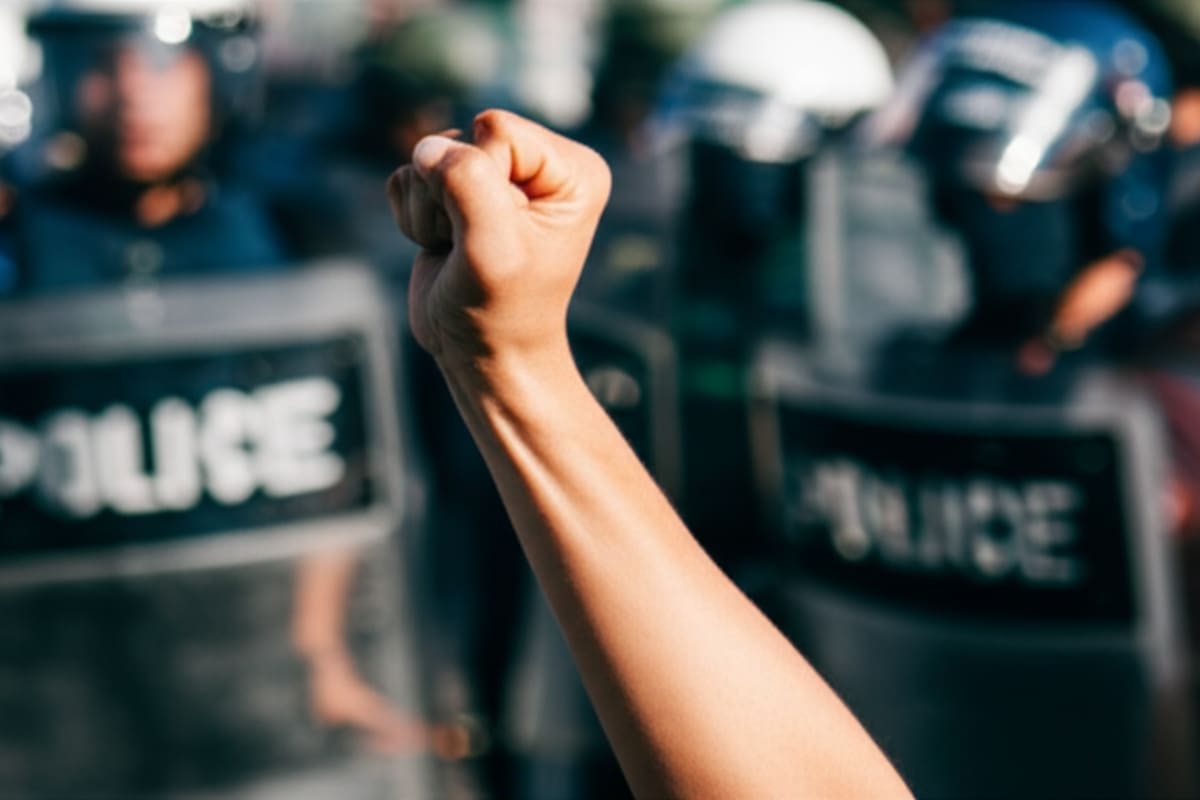Morocco: Police Kill Two Amid Gen Z Protests, Station Stormed

The recent deaths of two individuals at the hands of Moroccan police, during what authorities describe as an attempt to storm a police station, mark a grim escalation in the ongoing Gen Z-led protests gripping the North African nation. This incident, the first reported killings since the youth-driven unrest began, casts a harsh spotlight on the government's response to dissent and the underlying socio-economic frustrations fueling the movement, raising concerns among international human rights organizations.
The tragic loss of life raises urgent questions about state accountability and the right to peaceful assembly, placing Morocco at a critical juncture in its political evolution. Observers are carefully watching how the government will respond to the growing unrest. The Incident and Official Narrative. On October 2, 2025, Moroccan police confirmed they shot dead two people amidst a crowd attempting to overrun a police station in the capital city, Rabat. Initial reports suggest the protesters were attempting to voice their grievances related to economic inequality and lack of opportunity.
The official statement from the Interior Ministry frames the incident as a defensive measure, necessary to protect state property and personnel from what they characterized as a violent mob armed with rocks and Molotov cocktails
Background
The ministry maintains that officers acted within their legal boundaries, using lethal force only as a last resort
This narrative emphasizes the perceived threat to law and order, justifying the use of lethal force.
However, such incidents invariably raise serious questions about proportionality, de-escalation tactics, and human rights, especially when the targets are civilian protestors
Critics argue that non-lethal methods should have been prioritized
Independent verification of the events remains crucial to establishing a comprehensive understanding beyond official accounts
Several human rights groups have called for an independent investigation into the incident
Understanding Morocco's Gen Z Protests
These protests are not isolated incidents but rather a manifestation of deeper, systemic grievances felt by a significant segment of Morocco's youth.
The 'Gen Z' moniker is key here; this generation, born into a digital age, is highly aware of global standards of governance, economic opportunity, and personal freedoms
Their demands often center on:
- High Youth Unemployment: Despite government efforts, job creation has not kept pace with the burgeoning youth population. Graduates frequently find themselves without suitable employment, leading to widespread disillusionment. The unemployment rate among young Moroccans remains significantly higher than the national average.
- Economic Inequality: Perceived corruption and a lack of equitable distribution of wealth exacerbate feelings of injustice. Access to opportunities often appears tied to connections rather than merit, leading to a sense of hopelessness among many young people.
- Lack of Political Voice: Many young Moroccans feel marginalized from formal political processes, leading them to seek avenues for expression and change through street protests and digital activism. They feel their concerns are not adequately represented in parliament.
- Social Justice: Broader calls for reforms related to human rights, freedom of expression, and accountability are frequently interwoven with economic grievances. These demands include an end to police brutality, greater transparency in government, and respect for civil liberties.
Historically, Morocco has managed to maintain a degree of stability compared to some of its neighbors in the tumultuous Middle East and North Africa (MENA) region
However, the country is not immune to social unrest, as evidenced by the 'Arab Spring' protests in 2011 and the 'Hirak Rif' movement a few years later
These past movements, while ultimately suppressed, highlighted similar grievances regarding economic inequality and political marginalization
The current wave of Gen Z protests suggests that underlying tensions persist, and a new generation is finding its voice, often with greater digital prowess and less tolerance for traditional forms of governance
Regional and Global Context of Youth Activism
The Moroccan situation resonates with a global phenomenon of youth-led activism.
From climate change protests to Black Lives Matter, and from student movements in Latin America to pro-democracy movements in Asia, Gen Z has emerged as a potent force for change
They leverage social media not just for communication but for organizing, mobilizing, and shaping narratives, often bypassing traditional media gatekeepers
The speed at which information and solidarity can spread through these networks is unprecedented
In the MENA region specifically, youth unemployment and a desire for greater political freedoms have been consistent drivers of unrest, often met with varying degrees of state suppression
This pattern underscores a global generational shift where young people, empowered by digital tools, are increasingly vocal about issues ranging from climate change to human rights, often demanding greater transparency and participation from their governments
Their interconnectedness means that local grievances can quickly gain international attention, putting pressure on authorities to respond
This is particularly true in the age of social media, where footage and reports can quickly reach a global audience
A Southeast Asian Perspective: Shared Challenges and Cautionary Tales
For observers in Southeast Asia, the events in Morocco offer a compelling, albeit stark, case study of challenges that many nations in the region either currently face or are likely to encounter
While geographically distant, the socio-political dynamics bear striking resemblances:
- Youth Demographics and Economic Opportunity: Like Morocco, many Southeast Asian countries have large youth populations entering the workforce. Nations such as Indonesia, the Philippines, Thailand, and Vietnam grapple with the imperative to create sufficient, meaningful employment opportunities. Failure to do so can breed frustration and social unrest, as seen in Morocco. The competition for jobs is fierce, and many young people are forced to accept precarious or low-paying employment.
- Digital Native Activism: Southeast Asian Gen Z is equally adept at utilizing social media for social commentary, political organization, and protest. The 'Milk Tea Alliance,' for instance, demonstrated the power of digitally-connected youth across borders. This online solidarity movement, connecting activists from Thailand, Hong Kong, and Taiwan, shows the potential for cross-border collaboration and support.
Governments in the region are acutely aware of social media's role in shaping public opinion and mobilizing dissent. Many governments have implemented stricter internet regulations or employed sophisticated surveillance techniques to monitor online activity and curb dissent. Governance and Human Rights Concerns: Protests over corruption, governance transparency, and demands for greater civic space are not uncommon in Southeast Asia. Incidents of state force against protestors, as now reported in Morocco, serve as a potent reminder of the delicate balance between maintaining public order and upholding human rights.
The international community, including regional blocs like ASEAN, often scrutinizes such responses.
Concerns about human rights and the rule of law are frequently raised in diplomatic dialogues
Economic Disparity and Social Justice: Rapid economic growth in parts of Southeast Asia has not always translated into equitable wealth distribution, leading to pockets of discontent
Demands for social justice, environmental protection, and greater accountability from elites resonate deeply with Gen Z across both regions
For Southeast Asian governments and civil societies, the Moroccan incident serves as a cautionary tale.
It underscores the potential for rapid escalation when underlying grievances are not addressed through dialogue and reform, and when security forces resort to lethal force
It highlights the imperative to foster inclusive economic development, create channels for youth participation, and ensure police responses to protests adhere strictly to human rights standards
Investing in education and skills training for young people is also crucial to address the root causes of economic frustration
Conclusion: A Critical Juncture for Morocco
The deaths mark a dangerous turning point for Morocco.
The government faces the complex task of de-escalating tensions, addressing legitimate grievances, and restoring public trust, while simultaneously maintaining order
This requires a delicate balancing act between security and freedom of expression
The international community will be closely watching, with a focus on investigations into the killings, the protection of protestors' rights, and the government's long-term strategy for engaging its youthful population
Several international organizations have already expressed their concern and called for a transparent investigation
The manner in which these events are investigated and addressed will be pivotal in shaping Morocco's relationship with its youth and determining the path of stability and reform
Failure to address the root causes of discontent and to ensure justice for the recent deaths could further destabilize the nation, potentially leading to prolonged periods of social unrest
The ripple effects of such instability could also have implications for the wider region
For Southeast Asia, these events offer valuable, albeit painful, lessons on the global nature of youth activism, the perils of unaddressed socio-economic issues, and the critical importance of a nuanced, rights-respecting approach to dissent
Proactive measures, such as promoting inclusive governance and addressing economic inequalities, are essential to prevent similar crises from unfolding in the region
```